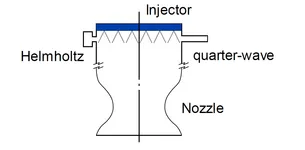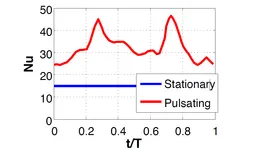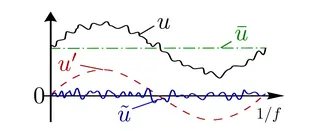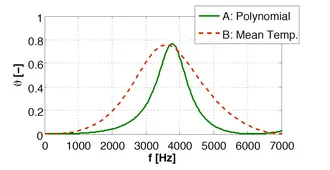Effects of Enhanced Heat Transfer in Oscillating Flows on the Thermal Load and Damping Behavior of Resonators
by A. Cárdenas Miranda and Wolfgang Polifke
Motivation


Liquid-propellant rocket engines are prone to thermoacoustic instabilities, which occur due to a feedback between the heat release and the acoustic field of the thrust chamber. The use of acoustic cavities as shown in Fig. 1 is a common practice to increase the stability margin of such engines.
These so called resonators dissipate acoustic energy in small frequency ranges around their eigenfrequency values, and thus have to be tuned according to the oscillation modes of the combustion chamber. Apart from its geometry, the eigenfrequency of a cavity depends also on the speed of sound of the gas inside it. Under operation, the superimposed oscillations may flush hot exhaust gases into the cavity, changing the gas composition and temperature distribution inside it.
Furthermore, the oscillations could produce a significantly enhanced heat transfer similar to the one observed in pulse combustor tailpipes, e.g. Fig. 2, increasing the thermal loads on chamber walls and leading again to different temperature distributions inside the cavities.
Objectives and Strategy
The influence of periodic flow oscillations on the thermal load, temperature distribution and damping behavior of resonators will be studied systematicly. For that purpose, a detailed analysis of momentum- and heat transfer mechanisms in oscillating and pulsating flows using computational methods like LES and DNS is planned.
To predict the impedance and dissipation of resonators influenced by the previously mentioned effects, the acoustic field will be investigated using the inhomogeneous wave equation. In order to get an accurate description of the stability behavior of the system, both the driving and damping mechanisms should be included in the analysis.
Preliminary Investigations
Enhanced Heat Transfer
The unsteady flow field in the thrust chamber and cavities might be decomposed into a time invariant mean, a periodic and a turbulent part, see Fig. 4:

The periodic fluctuations display an organized character with definite frequency f, while the turbulent part displays chaotic random fluctuations. If the mean part is equal to zero, one speaks of an oscillating flow and if the mean doesn’t vanish, of a pulsating flow.

As a starting point for the investigation of enhanced heat transfer, a simplified laminar incompressible flow past a heated flat plate has been numerically investigated with a CFD tool. The imposed velocity amplitudes are high enough to induce flow reversal. Enhanced heat transfer has been observed for higher amplitude ratios ε as depicted in Fig. 5. The axial coordinate ξ represents a dimensionless Strouhal number, which has been formed with the local plate distance, the oscillating frequency and the average mean flow velocity.

Damping Behavior of Resonators
The efficiency of a resonator can be defined by its absorption coefficient ϑ, which is the ratio of energy absorbed by the resonator to the energy of the incident wave. To account for the sensitivity in terms of temperature inhomogeneity, a quarter wave resonator with a temperature profile along the cavity has been studied. The imposed polynomial profile is similar to the one expected under real operating conditions.

Fig. 3 shows the absorption coefficient plotted against frequency. Even if the eigenfrequency is only shifted about 10%, the bandwith of operation is considerably thinner with a temperature inhomogeneity.
References
[1] Dec, J., Keller, J. & Arpaci V., Heat Transfer Enhancement in the Oscillating Turbulent Flow of a Pulse Combustor Tailpipe, Int. Journal of Heat and Mass Transfer, 1992